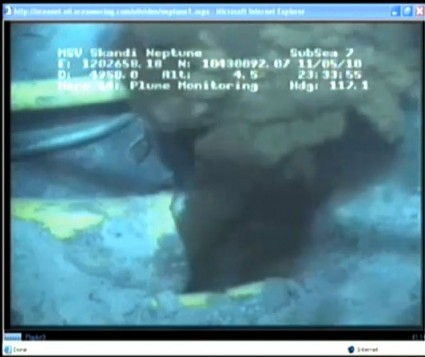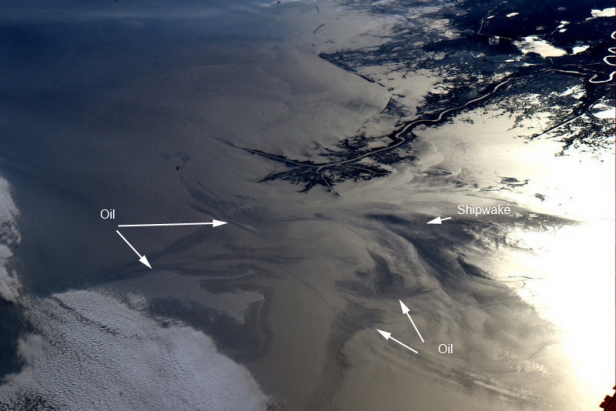Rep. Cliff Stearns (R-Fla.): “Okay. What is the current spill per day today?”
Lamar McKay, President and Chairman of BP America: “The current estimate is 5,000 barrels a day.”
— From hearings (PDF) held by the House Committee on Energy and Commerce, Wednesday, May 12, 2010
 Still from a May 11 video of oil and gas streaming from the larger of two leaks in the Deepwater Horizon well. For weeks, government officials, politicians, oil industry executives, and journalists — including me — have been repeating the “fact” that oil is gushing from the Deepwater Horizon leak at the rate of 5,000 barrels per day.
Still from a May 11 video of oil and gas streaming from the larger of two leaks in the Deepwater Horizon well. For weeks, government officials, politicians, oil industry executives, and journalists — including me — have been repeating the “fact” that oil is gushing from the Deepwater Horizon leak at the rate of 5,000 barrels per day.
As recently as Wednesday, during hearings on the disaster held by the House Committee on Energy and Commerce, that figure was taken as gospel. Rep. Joe Barton (R-Texas), that tireless champion of the oil industry, even used it to downplay the magnitude of the spill at the House Energy and Commerce Committee Hearings. “So far this spill has produced a little over 100,000 barrels [based on the 5,000/day figure]. Now, that, in and of itself, is a significant spill. It is a nontrivial accident, but it is nowhere near yet the order of magnitude of other accidents that have happened around the world,” he declared.
Well, we now know the 5,000 barrel estimate is likely too low by an order of magnitude. NPR broke the story Thursday afternoon:
The amount of oil spilling into the Gulf of Mexico is at least 10 times the size of official estimates, according to an exclusive NPR analysis.
At NPR’s request, experts examined video that BP released Wednesday. Their findings suggest the BP spill is already far larger than the 1989 Exxon Valdez accident in Alaska, which spilled at least 250,000 barrels of oil.
The magnitude of those numbers is stunning. If the NPR analysis correct, we’re getting at least a Valdez-level spill every five days. Equally stunning, though, is that the government’s Deepwater Horizons Response team has allowed the 5,000-barrel number to stand. Here’s NPR:
BP has said repeatedly that there is no reliable way to measure the oil spill in the Gulf of Mexico by looking at the oil gushing out of the pipe. (Watch this video of the crater’s plume.) But scientists say there are actually many proven techniques for doing just that.
In other words, BP is lying when it says there are no accurate ways of measuring the spill — and the federal response team has played along.
Indeed, there is active complicity. The 5,000-barrel number originally came from analysis of the spill at the ocean surface by the National Oceanic and Atmospheric Administration in late April. Before that, BP had been claiming its best estimate was a flow of of just 1,000 barrels. A Friday New York Times piece describes how the NOAA’s estimate originally came about:
The issue of how fast the well is leaking has been murky from the beginning. For several days after the April 20 explosion of the Deepwater Horizon rig, the government and BP claimed that the well on the ocean floor was leaking about 1,000 barrels a day.
A small organization called SkyTruth, which uses satellite images to monitor environmental problems, published an estimate on April 27 suggesting that the flow rate had to be at least 5,000 barrels a day, and probably several times that.
The following day, the government — over public objections from BP — raised its estimate to 5,000 barrels a day. A barrel is 42 gallons, so the estimate works out to 210,000 gallons per day.
According to NPR, much more accurate assessments of a leak’s rate can be made by analyzing film footage at the wellhead. And that’s how the expert contacted by NPR made his estimate:
Steven Wereley, an associate professor of mechanical engineering at Purdue University, analyzed videotape of the seafloor gusher using a technique called particle image velocimetry.
A computer program simply tracks particles and calculates how fast they are moving. Wereley put the BP video of the gusher into his computer. He made a few simple calculations and came up with an astonishing value for the rate of the oil spill: 70,000 barrels a day — much higher than the official estimate of 5,000 barrels a day. The method is accurate to a degree of plus or minus 20 percent.
Now, BP only publicly released footage at the wellhead on Thursday, but presumably it’s had cameras down there since soon after the explosion. In keeping that footage from the media and not using the best available techniques for estimating the spill rate, BP has manipulated information to hide the severity of the calamity from the public.
But that is to be expected from a company desperately trying to limit its financial losses from a disaster that has clearly spun out of its control. The real question is why the Obama Administration — ostensibly so different from its oil-stained predecessor — has allowed it to do so. If something as basic as the official leak rate has proven to be fictional, one has to wonder what other misinformation is emerging of the Deepwater Horizon Response effort.



